 The Industrial Revolution started with the mechanization of the textile-industry (1740-1790) in England.
The Industrial Revolution started with the mechanization of the textile-industry (1740-1790) in England.
A new collaboration concept the Mill, later translated in the Factory, is invented. The Industrial Revolution is preceded by the Renaissance.
The Renaissance is a Creative Phase.
The Industrial Revolution is a Social phase. A Social phase changes the way people cooperate.
Small scale cooperation structures were destroyed and replaced by large-scale cooperation structures.
The Industrial Revolution not only changed the way people cooperated in labour. It also changed the way Cities and Countries cooperated.
At the end of this phase (the Second World War) Europe and the World (UN, China, and India) started to Unite. Cooperation on the Level of the World became possible but was finally not realized.
The French Revolution (1789) breaks the power of the Aristocracy. The Bourgeois (the merchants, the entrepreneurs, the middle class) use the Mill to produce cheap standardized products on a large scale. They became the new Rulers of Society.
The mill and later the factory not only destroyed the Aristocracy.
It also destroyed the Small Scale Collaboration Structure of the Guilds. The Guilds, operating on the level of the City, took care of almost everything at that time.
They operated hospitals, educational facilities and insurance. When the mills turned into factories many people lost their job. The big cities were populated with very poor and hungry people.
Nobody took care of the sick and the old. They became the Prolitariat, the Under-Class. The existence of the Prolitariat produced a huge tension in society.
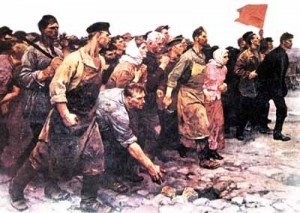 This tension was resolved when many pressure groups or movements (Conservatives, Liberals, Socialists, and Communists) finally agreed upon new large scale institutions.
This tension was resolved when many pressure groups or movements (Conservatives, Liberals, Socialists, and Communists) finally agreed upon new large scale institutions.
The State, Parliament, Democracy, Voting, and The Union came into existence.
The Social Welfare State was constructed. Government took care of almost everybody.
The first Cotton Mill was opened in 1742. In 1762 Hargreaves invents the spinning jenny. It was operated by hand.
With the invention of the steam-machine (1769, Watt) manual labour was not needed anymore.
In 1785 the first mill was opened that used a steam-machine (the power loom).
The Steam Machine became a Major Paradigm. It highly influenced Physics (ThermoDynamics, Entropy) and Psychology (Freud).
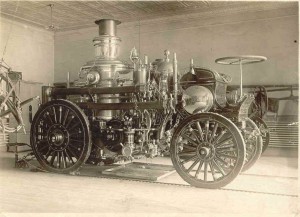 In 1781 Kant wrote his book Kritik der reinen vernunft. He excluded the Imagination (illusions) and the Emotions (love, care, values, quantity) out of reasoning and introduced the concept of mechanized thinking (Logic). Kant excluded Art (Imagination) and Religion (the Emotions) and invented Science.
In 1781 Kant wrote his book Kritik der reinen vernunft. He excluded the Imagination (illusions) and the Emotions (love, care, values, quantity) out of reasoning and introduced the concept of mechanized thinking (Logic). Kant excluded Art (Imagination) and Religion (the Emotions) and invented Science.
Mechanized (Scientific) Thinking was used to Optimize the Mill. Slowly it grew into a (big) factory. At the end of the Industrial Revolution Logical reasoning produced its most briljant artefact, the All Purpose Computer. The Computer became a major Paradigm.
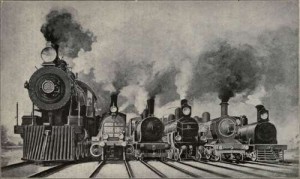 Between 1790 and 1840 the world was covered with Railroads. They facilitated the spread of the Industrial Revolution.
Between 1790 and 1840 the world was covered with Railroads. They facilitated the spread of the Industrial Revolution.
Cities flourished and died according to the distance to a railroad station (A node). Many infrastructures were created in this period (Telephone, Sewers, Water, Gas, and Electricity). Later the concept of the railroad was implemented in Traffic (Highway) and Computers (networks, hubs, servers). The Railroad Network became a major Paradigm.
Mechanic thinking resulted in Standardization. Between 1890 and 1940 Mass-production, Mass-consumption and Mass-media dominated society.
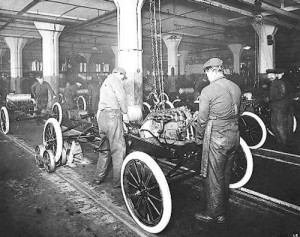 The first step was set by Henry Ford and Frederick Winslow Taylor with the production of the T-Ford. The theories of Taylor are until now (most of the time not recognized) used in many forms to optimize work-processes.
The first step was set by Henry Ford and Frederick Winslow Taylor with the production of the T-Ford. The theories of Taylor are until now (most of the time not recognized) used in many forms to optimize work-processes.
The end of optimization is reached when everything is turned into a Utility. A Utility is a Network that operates without Human Beings and transports Objects.
When we look at the Industrial Revolution from a higher perspective we can see the elements of the Cycle at work.
A phase of Creativity is followed by a Social Phase. It is the phase of Power Conflicts (Competition) and the construction of new Movements, new Groups and finally of new Institutions (The State, The Corporation).
The Hierarchy was the major control paradigm of this period. Everybody wanted to move to “the Top”. The Race to the Top was also visible in architecture. The SkyScraper with the Management at the Top became the Symbol of Power.
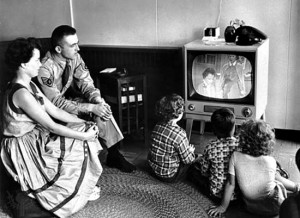 The Industrial Revolution gave the Masses, the Slaves of the Middle Ages a better place. They changed from a Slave into a Consumer.
The Industrial Revolution gave the Masses, the Slaves of the Middle Ages a better place. They changed from a Slave into a Consumer.
The Slave was dominated by his Owner. A Consumer is dominated by his Senses. On the Macro-level we see a move from the world-view of Control/Social (Master/Slave) to a Sensory/Social-pattern.
Will Mc Whinny called the Game of Sensory/Social The Game of the Market. The Industrial Revolution produced the Game of the Market.
At the end of this period the Masses controlled the Market. We are now in a demand oriented economy. This created a big problem for the mass-producers.
They controlled the masses and are desperatly trying to keep their position by Manipulation of the Media.
What is Going to Happen?
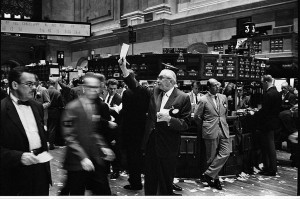 On the level of the Kondratiev-cycle (Period 50 years) a phase of Creativity and the Individual was started in 1950.
On the level of the Kondratiev-cycle (Period 50 years) a phase of Creativity and the Individual was started in 1950.
This phase ended around 2000.
The move to the Individual challenged the structures of Mass-Production. People wanted to be treated as a Unique Human Being.
Industry found a solution to this need. They invented Mass Customization and User Involvement and went on with the Game of the Market.
This phase is now followed by a Social Phase (Start 2000). The Customer (the new Ruler) is organizing itself in Smart Customer Networks.
The Very Long Cycle (Precession, Period 25.000 years) and the Cycle of Culture (Periodicity 1250 year) is also changing its focus.
On the level of Culture we are moving to the Centre. We are converging on a new and unknown level, Earth. During the Social Phase of the Industrial Revolution huge collaboration structures were formed (EG, UN, NATO, China, India, …). These structures are challenged by the Individual in the Next Phase. The solution of this conflict is a network of small local structures that is part of a large global network (“Think Global, Act Local”).
The precession cycle is moving from the Dark Phase into the Light. This is the most interesting and unknown development. Current Human history has never experienced a shift from the Kali Yuga to the Golden Age. The Golden Age is a period of intense spiritual development, a movement to a New Level of Conscioussness.
It shows itself in a move to religion and mysticism but also in a new awareness about what is really happening in the world. This new awareness is frightening to most of the people. They cannot understand the major changes that are visible. The predictable future is gone. Everything is on the move and the movement is excellerating culminating in Point Omega, the Big Leap into Nothingness.
Long Term Phases always dominate short term phases. The effect of this will be tremendous and almost unpredictable. An unpredictable future is a Future without a Perspective.
Some people expect a dramatic negative change. They are waiting for the Apocalyps. Some people expect the Return of Paradise and a jump to a higher consciousness.
I really don’t know what will happen.
If you read my blogs I am constantly trying to find the solution of this very complex conjunction of cycles. I keep you informed.
















 The Industrial Revolution started with the mechanization of the textile-industry (1740-1790) in England.
The Industrial Revolution started with the mechanization of the textile-industry (1740-1790) in England. This tension was resolved when many pressure groups or movements (Conservatives, Liberals, Socialists, and Communists) finally agreed upon new large scale institutions.
This tension was resolved when many pressure groups or movements (Conservatives, Liberals, Socialists, and Communists) finally agreed upon new large scale institutions.  In 1781 Kant wrote his book Kritik der reinen vernunft. He excluded the Imagination (illusions) and the Emotions (love, care, values, quantity) out of reasoning and introduced the concept of mechanized thinking (Logic). Kant excluded Art (Imagination) and Religion (the Emotions) and invented Science.
In 1781 Kant wrote his book Kritik der reinen vernunft. He excluded the Imagination (illusions) and the Emotions (love, care, values, quantity) out of reasoning and introduced the concept of mechanized thinking (Logic). Kant excluded Art (Imagination) and Religion (the Emotions) and invented Science. Between 1790 and 1840 the world was covered with Railroads. They facilitated the spread of the Industrial Revolution.
Between 1790 and 1840 the world was covered with Railroads. They facilitated the spread of the Industrial Revolution. The first step was set by Henry Ford and Frederick Winslow Taylor with the production of the T-Ford. The theories of Taylor are until now (most of the time not recognized) used in many forms to optimize work-processes.
The first step was set by Henry Ford and Frederick Winslow Taylor with the production of the T-Ford. The theories of Taylor are until now (most of the time not recognized) used in many forms to optimize work-processes. The Industrial Revolution gave the Masses, the Slaves of the Middle Ages a better place. They changed from a Slave into a Consumer.
The Industrial Revolution gave the Masses, the Slaves of the Middle Ages a better place. They changed from a Slave into a Consumer. On the level of the
On the level of the 